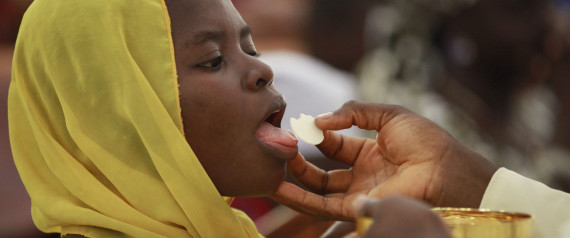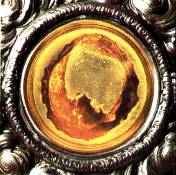Lanciano, Italy 8th Century A.D.
CLOSE UP OF THE EUCHARISTIC MIRACLE IN LANCIANO, ITALY
During Holy Mass, after the two-fold consecration, the host was changed into live Flesh and the wine was changed into live Blood, which coagulated into five globules, irregular and differing in shape and size.
The Host-Flesh, as can be very distinctly observed today, has the same dimensions as the large host used today in the Latin church; it is light brown and appears rose-colored when lighted from the back.
The Blood is coagulated and has an earthy color resembling the yellow of ochre.
Various ecclesiastical investigation ("Recognitions") were conducted since 1574.
In 1970-'71 and taken up again partly in 1981 there took place a scientific investigation by the most illustrious scientist Prof. Odoardo Linoli, eminent Professor in Anatomy and Pathological Histology and in Chemistry and Clinical Microscopy. He was assisted by Prof. Ruggero Bertelli of the University of Siena.
The analyses were conducted with absolute and unquestionable scientific precision and they were documented with a series of microscopic photographs.
These analyses sustained the following conclusions:
The Flesh is real Flesh. The Blood is real Blood.
The Flesh and the Blood belong to the human species.
The Flesh consists of the muscular tissue of the heart.
In the Flesh we see present in section: the myocardium, the endocardium, the vagus nerve and also the left ventricle of the heart for the large thickness of the myocardium.
The Flesh is a "HEART" complete in its essential structure.
The Flesh and the Blood have the same blood-type: AB (Blood-type identical to that which Prof. Baima Bollone uncovered in the Holy Shroud of Turin).
In the Blood there were found proteins in the same normal proportions (percentage-wise) as are found in the sero-proteic make-up of the fresh normal blood.
In the Blood there were also found these minerals: chlorides, phosphorus, magnesium, potassium, sodium and calcium.
The preservation of the Flesh and of the Blood, which were left in their natural state for twelve centuries and exposed to the action of atmospheric and biological agents, remains an extraordinary phenomenon.
Fig. 1 - Eosine x 200. Overall histological aspect of a Flesh sample with fibers collected in bundles with longitudinal orientation as it occurs in the outer surface layers of the heart.
Fig. 2 - Miracle Heart in Lanciano. Mallory x 250. An artery and, very close, a branch of the vagal nerve.
Fig. 3 - Miracle Heart in Lanciano. Mallory x 400. Evidence of the "Rough" aspect of the endocardium; the syncytoid structure of the myocardial tissue.
Fig. 4 - Elution-absorption test x 80. Above: Hemagglutination test on blood sample in Lanciano: on the left, anti A serum used; on the right, anti-B serum. Below: hemoagglutination test on a Flesh sample in Lanciano: left, with anti-A serum, right,with anti-B serum. It appears thus that the Flesh and the Blood in Lanciano belong to AB blood group.
Fig. 5 - Electro-phoretic pattern of Blood proteins (Cromoscan photometer). The profile of serum fractions is normal and superimposable to that of a fresh serum sample.
In conclusion, it may be said that Science, when called upon to testify, has given a certain and thorough response as regards the authenticity of the Eucharistic Miracle of Lanciano.
MORE








No comments:
Post a Comment